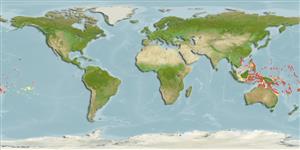>
Gobiiformes (Gobies) >
Gobiidae (Gobies) > Gobiinae
Etymology: Istigobius: Greek, istios = sail + Latin, gobius = gudgeon (Ref. 45335).
More on author: Herre.
Environment: milieu / climate zone / depth range / distribution range
Ecología
marino asociado a arrecife; rango de profundidad 0 - 30 m (Ref. 1602). Tropical; 20°N - 25°S
Western Pacific: Philippines and Indonesia to Kiribati and Fiji, south to Rowley Shoals in the eastern Indian Ocean and the Great Barrier Reef. Reported from the Ryukyu Islands (Ref. 559).
Tamaño / Peso / Age
Maturity: Lm ? range ? - ? cm
Max length : 10.8 cm TL macho / no sexado; (Ref. 11344)
Espinas dorsales (total): 7; Radios blandos dorsales (total): 10-11; Espinas anales 1; Radios blandos anales: 9 - 10; Vértebra: 26. Upper pectoral fin rays entire. Predorsal with 7-9 cycloid scales; trunk with ctenoid scales. Segmented and non branching caudal rays 4, branching 13. Body color yellowish white; 2 brown diagonal lines from preoperculum to upper jaw, connected by a single line; 2 almost vertical brown lines on operculum. 4th spine of 1st dorsal fin longest. No sharp distinction between sexes in pigmentation and elongation of 2nd dorsal, pelvic and anal fins. Males sometimes with 3-4 dusky vertical bars on abdomen (Ref. 420); fully united pelvic fins with well-developed frenum; longitudinal scale series 29-32; predorsal scales 7-9, reaching interorbital space; absence of scales on cheek or opercle; depth of body 4.7-6.1 in SL (Ref. 90102).
Solitary (Ref. 90102). Occurs in sandy areas with living corals and coral rubble in clear waters, Ref. 48637.
Life cycle and mating behavior
Madurez | Reproducción | Puesta | Huevos | Fecundidad | Larva
Genital papilla of male terminating to side of anal spine. Papilla of female truncate and terminating posteriorly well before origin of anal fin.
Murdy, E.O. and D.F. Hoese, 1985. Revision of the gobiid fish genus Istigobius. Indo-Pac. Fish. (4):41 p. (Ref. 420)
IUCN Red List Status (Ref. 130435)
Threat to humans
Harmless
Human uses
Más información
ReferenciasAcuiculturaPerfil de acuiculturaRazasGenéticaElectrophoresesheritabilidadEnfermedadesProcesamientoNutrientsMass conversion
Herramientas
Special reports
Download XML
Fuentes de Internet
Estimates based on models
Preferred temperature (Ref.
123201): 25.5 - 29.3, mean 28.6 °C (based on 1556 cells).
Phylogenetic diversity index (Ref.
82804): PD
50 = 0.5010 [Uniqueness, from 0.5 = low to 2.0 = high].
Bayesian length-weight: a=0.00708 (0.00333 - 0.01504), b=3.09 (2.92 - 3.26), in cm total length, based on LWR estimates for this (Sub)family-body shape (Ref.
93245).
Nivel trófico (Ref.
69278): 3.3 ±0.4 se; based on size and trophs of closest relatives
Resiliencia (Ref.
120179): Alto, población duplicada en un tiempo mínimo inferior a 15 meses (Preliminary K or Fecundity.).
Fishing Vulnerability (Ref.
59153): Low vulnerability (10 of 100).
Nutrients (Ref.
124155): Calcium = 130 [59, 246] mg/100g; Iron = 0.752 [0.389, 1.441] mg/100g; Protein = 17.9 [16.0, 19.7] %; Omega3 = 0.0927 [, ] g/100g; Selenium = 25.7 [12.3, 56.5] μg/100g; VitaminA = 120 [32, 410] μg/100g; Zinc = 1.97 [1.28, 2.90] mg/100g (wet weight);
